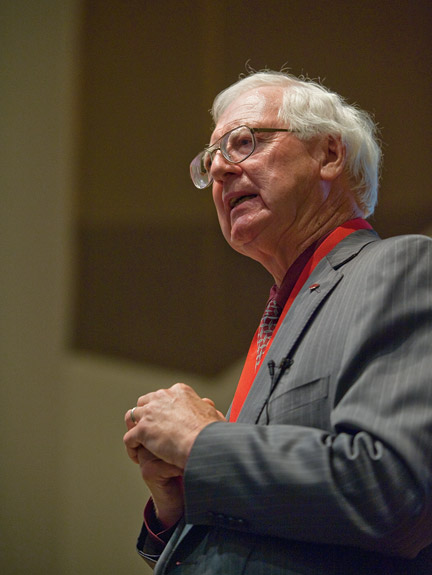As a teen, Roger McClellan ’60 D.V.M. went to work at his high school farm. By helping manage a flock of sheep that were a control group in a Hanford nuclear facility study, he became part of a major research project on radioactivity in animals. The work put him in touch with Leo Bustad, at the time the research veterinarian at Hanford and later the dean of the College of Veterinary Medicine at Washington State University.
Bustad’s study focused on ungulates consuming the radioiodine that had been deposited on pasture land on the Hanford site, which was then run by General Electric. Bustad would often stop by the high school farm to check on the control flock.

McClellan’s first encounter with WSU was about that same time. “I came to Pullman in the spring of ’53, one of eight hundred Future Farmers of America here for a convention,” he says. “Most of us left saying we were going to return as students. Many of us did.”
This fall, after a career in inhalation toxicology, science, and public policy, McClellan returned to Pullman with his wife Kathleen ’62 to be honored as Washington State’s Regents’ Distinguished Alumnus.
He is the archetype of a WSU veterinary alumnus, says Acting Provost and Dean of Veterinary Medicine Warwick Bayley, citing McClellan’s long and successful career and his dedication to the University.
“My career has really been intertwined in terms of science and policy,” says McClellan. He learned at Hanford about issue-resolving science and public policy, which set the path for the rest of his career.
As an undergraduate McClellan tackled three majors: engineering, economics, and pre-veterinary medicine. His obvious path seemed to lead to vet school. But once he had second thoughts. He recalls his anatomy class, “Two students to a dog, four students to a cow, eight to a horse,” he says. “You kind of wondered at that time, ‘Is this really for me?’”
He was a good student, though maybe not always the ideal student–at least from an administrator’s perspective. “At the end of every semester I’d write a letter to the dean critiquing the program,” says McClellan. “He didn’t seem to appreciate it.”
Throughout college McClellan found summer jobs back at Hanford working first in an engineering internship and then helping Bustad. The work gave him opportunities to work all over the plant, seeing sides of it he didn’t see growing up. The next two summers his work with Bustad focused on animal exposures to toxins. He was able to take the research he did at Hanford on Cesium 137 metabolism and turn it into an honors thesis.
The spring of his graduation, Hanford called again. “The next thing you know I’m signed on at Hanford as a biological scientist,” says McClellan. He took that job for $8,700 a year. “I thought it was good when I started,” he says. “But later, I decided a little more would be better.”
Combining his veterinary work with science research suited him. “I wouldn’t have fit in with the little old ladies and their pussy cats,” he says. While he was doing research at Hanford, he also enrolled in management training. “It turned out to be extraordinarily valuable,” says McClellan.
A few years into his time at Hanford, the U.S. Atomic Energy Commission invited Bustad to serve as a scientist in Washington, D.C. Bustad sent McClellan instead. The post with the AEC Division of Biology and Medicine offered the young veterinarian insight into national research projects, government funding, and human health concerns. It also led to an appointment at the Lovelace Biomedical and Environmental Research Institute in Albuquerque, New Mexico. He was hired in 1966 to start a lab there. He was just 29.
One of the things the Lovelace program looked at was what happens with a Chernobyl-type accident resulting in radioactivity in the air. What are the risks? “That led to developing a very strong aerosol science program,” he says. The group studied a suite of aerosol fission products, with the help of a good team of physicists, chemists, statisticians, and veterinarians. “We became a leading lab in inhalation toxicology,” says McClellan. “I’m a very strong advocate of team research. Most of the problems in the real world require a multidisciplinary team.”
After leaving Lovelace, he served as president of the Chemical Industry Institute of Toxicology until 1999. Throughout his career, he has advised both public and private research efforts. He served on the original science advisory board for the EPA and was elected to the Institute of Medicine of the National Academy of Sciences.
